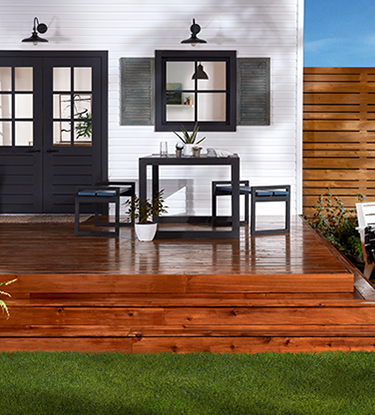Maintain and Beautify: Unveiling the Art of Fence Staining
Selecting the Right Discoloration for Your Fencing: Tips and Considerations
When it comes to maintaining and improving the look of your fence, picking the right tarnish is crucial. We will discover the different types of fence spots, aspects to think about before choosing a tarnish, ideas for preparing your fence for staining, and the distinctions in between oil-based and water-based stains. In addition, we will certainly dive right into picking the ideal tarnish shade to match your fencing and enhance your exterior area.
Comprehending Various Sorts Of Fence Stains

On the various other hand, water-based stains are made from acrylic or latex and offer a much more subtle shade to the timber. Water-based discolorations are less complicated to clean up and have a much faster drying out time contrasted to oil-based stains.
Selecting in between oil-based and water-based discolorations relies on various aspects, including personal preference, the wanted appearance, and the level of maintenance needed. Oil-based stains are recommended for fence high-traffic locations or those continuously subjected to extreme climate condition. fence staining and sealing. Water-based stains, on the various other hand, are a preferred choice for fencings in suburbs where look and ease of use are essential
Understanding the distinctions in between oil-based and water-based stains helps home owners make an informed choice when choosing the best tarnish for their fencing. Taking into consideration the certain requirements of the fence, such as its place, exposure to sunlight, and wanted aesthetic, will guarantee that the selected tarnish gives lasting security and improves the total charm of the fence.
Elements to Take Into Consideration Prior To Picking a Discoloration

An additional variable to consider is the sort of wood your fence is made of. Various sorts of timber soak up spots in different ways, resulting in varying degrees of shade strength and longevity. Softwoods like ache may require even more constant discoloration contrasted to hardwoods like cedar or redwood. Additionally, particular woods might be extra prone to concerns like rot or insect infestation, which might affect the choice of stain to safeguard and preserve the fencing.
The climate and weather in your location ought to also be thought about. If you reside in an area with extreme winter seasons or high moisture, you may need a discolor that provides extra defense against wetness and UV rays. If your fencing is exposed to guide sunlight for lengthy durations, a tarnish with UV preventions can assist stop fading and staining.
Last but not least, it is very important to consider your desired aesthetic. Various spots offer numerous colors and surfaces, allowing you to customize the appearance of your fence (fence staining). Think about the overall design and style of your home, in addition to any local regulations or property owner association guidelines that might determine the appropriate stain colors
Tips for Preparing Your Fence for Staining
Cleansing the fence is an essential action as it eliminates dust, gunk, and any type of previous coverings that might conflict with the staining process. Rub the surface carefully, paying additional attention to locations with persistent spots or mold and mildew.
This action is essential as tarnishing a moist or damp surface can lead to poor bond and an unequal surface. Guarantee that the fence is completely dry prior to continuing with the discoloration procedure.
Before staining, examine the fence for any type of damages, such as loose boards or nails. This product helps to open up the timber pores, permitting the tarnish to penetrate a lot more effectively and equally.

Comparing Oil-Based and Water-Based Spots
When selecting a discolor for your fencing, it is essential to contrast the characteristics and benefits of water-based and oil-based stains. Both sorts of discolorations have find out here their own advantages and factors to consider, so it is crucial to comprehend the distinctions in between them.
Oil-based spots are known for their resilience and resistance to tear and wear. Furthermore, oil-based discolorations have a tendency to last longer than water-based spots, making them a popular selection for fences.
On the various other hand, water-based discolorations are extra eco friendly and much easier to cleanse up. They might not provide the same level of protection as oil-based spots, particularly in extreme weather condition problems.
Inevitably, the choice in between water-based and oil-based discolorations depends upon your certain requirements and preferences. When making your choice, think about variables such as durability, ecological impact, and simplicity of application. Consulting with a professional or looking for recommendations from specialists can also assist ensure that you select the best tarnish for your fence.
Picking the Right Stain Shade for Your Fencing
The selection of a proper stain color for your fencing is an important facet of improving its visual appeal and enhancing the general layout of your outside space (fence staining). The appropriate tarnish shade can transform a plain, common fencing right into a striking centerpiece that includes deepness and personality to your residential or commercial property
When choosing a discolor color for your fencing, it is necessary to take into consideration the design and architecture of your home. Natural tones such as neutrals and browns can produce a warm and welcoming appearance if you have a classic or conventional style home. On the various other hand, if you have a modern or modern home, you might consider going with vibrant and lively colors that make a declaration.
One more variable to consider is the all-natural environments of your residential or commercial property. If you have a great deal of plant, a stain shade that enhances the all-natural landscape, such as greens or deep reds, can develop a unified and cohesive appearance.
Furthermore, it deserves thinking about the maintenance needed for different discolor colors. Lighter colors have a tendency to reveal dirt and use more quickly, while darker colors can hide flaws and need much less frequent touch-ups.
Eventually, the selection of stain color for your fence ought to show your individual design and choices - deck staining nashville tn. Take the time to consult and check out various options with professionals if required, to make certain that you choose the excellent stain color that boosts the beauty and charm of your fencing
Conclusion
In conclusion, when it comes to selecting the best discolor for your fencing, it is crucial to recognize the various kinds of spots offered and take into consideration factors such as longevity and preferred look. Choosing the ideal discolor shade can enhance the general aesthetic appeals of your fencing.
We will certainly explore the different kinds of fence spots, aspects to consider before picking a stain, ideas for preparing your fencing for discoloration, and the differences in between oil-based and water-based discolorations.Distinguishing in between water-based and oil-based spots is essential when recognizing various types of fence spots. Water-based spots are simpler to clean up and have a faster drying time compared to oil-based discolorations. In addition, oil-based stains tend to last longer than water-based stains, making them a preferred selection for fences.
In final thought, when it comes to selecting the appropriate tarnish for your fencing, it is essential to recognize the different kinds of discolorations offered and take into consideration factors such as longevity and preferred look.